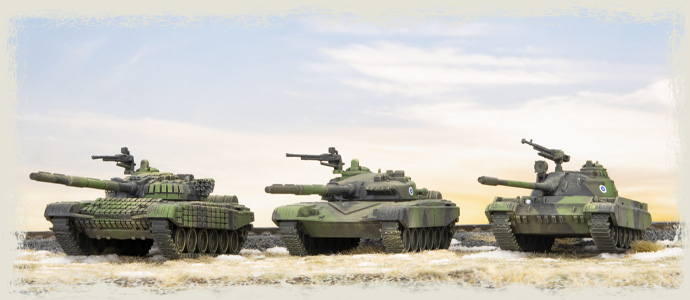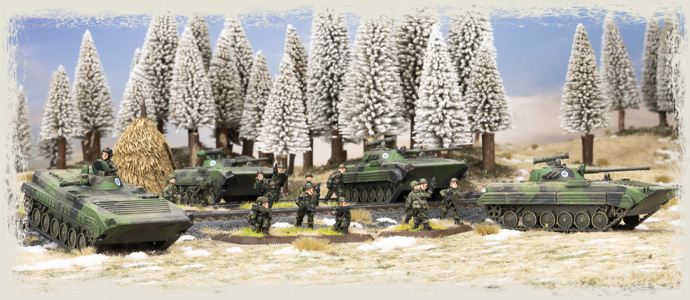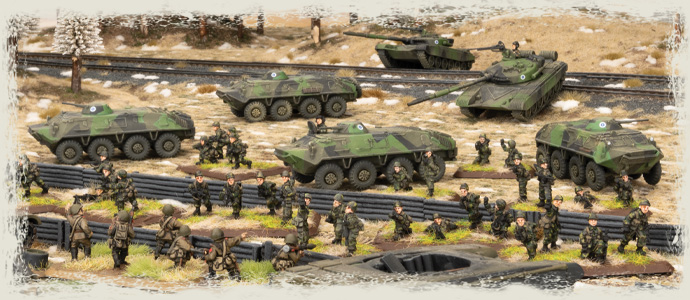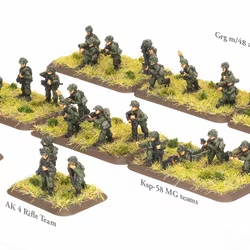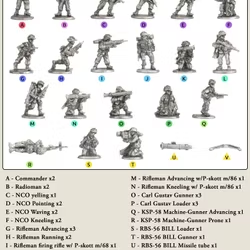World War III: Nordic Forces - WW3-08
- 188 kr
It’s 1985 and the Cold War just got hot!Löjtnant Lars Nilsson watched the road from the cupola of his Strv 103 S-Tank. His platoon had been positioned in a
Produkten är tyvärr slut i lager. :(
Artikelnummer:
WW3-08
Leverantör:
Battlefront Miniatures Ltd
It’s 1985 and the Cold War just got hot!
Löjtnant Lars Nilsson watched the road from the cupola of his Strv 103 S-Tank. His platoon had been positioned in a treeline waiting for the enemy to appear since the previous day.
About mid-morning the first Soviet vehicles crested a dip in the road. Nilsson’s gunner/driver, Karlsson, spotted it first, “BRDM, 1000 metres, sir,” he stated before ducking back into his hatch to take up his position.
“Enemy vehicles, 1000 metres east, on road, free fire,” Nilsson informed his platoon.
Meanwhile, Karlsson had already shot at the Soviet armoured car. The sabot projectile tore through the lightly armoured vehicle, and its smoking wreck rolled off the road into a tree.
Nilsson then saw the trees dividing a field shaking, before a tank emerged into the field.
“Tanks, 1500 metres, treeline and field,” he informed the platoon. A ripple of 105mm fire travelled down the platoon’s position.
Both Norway and Denmark were quick to join NATO after its establishment in 1949. However, Sweden and Finland remain neutral, each for their own reasons, but always wary of their massive Soviet neighbour.
Inside You Will Find:
Background on World War III in Finland, Sweden, Norway, and Denmark.
Instructions on how to build:
Finnish T-72FM1, T-72FM2, or T-55M Armoured Companies, and BMP-1 or BTR-60 Jääkäri Companies,
Swedish Strv 103 S-Tank or Strv 104 Centurion Tank Companies, and Pbv 302 Armoured Rifle Companies,
Norwegian Leopard 1 Tank Squadrons, and M113 Storm Squadrons,
Danish Leopard 1 or Centurion DK Tank Squadrons, and M113 Armoured Infantry Companies.
Three scenarios featuring World War III: Nordic Forces.
Detailed painting guides to help you prepare your Forces for combat.
Finland
The Soviet high command had a number of wartime plans for Finland. Some involved the invasion and conquest of the whole of Finland, with Helsinki, Vaasa, and Oulu as the primary Soviet objectives and even involved the use of Finland as a launch point for the invasion of Sweden. Other plans varied between limited offensives, allowing Finland to maintain its neutrality, or requests for access to Finnish territory for troop movements.
However, the Soviet Union’s main goal was the domination of the Norwegian Sea and Northern Norway to support the free passage of its Northern Fleet into the North Sea and the Atlantic Ocean. For this, they initially demanded the Finns give them free passage across Lapland for Soviet northern forces attacking Norway. When the Finns refused, the Soviets instead attacked through Lapland towards Norway.
Other Soviet forces also attacked southern Finland, tying down the bulk of the Finnish Defence Forces around their main population centres.
Finnish Formations A Finnish T-72FM1 Armoured Company is equipped with three tank platoons armed with the T-72FM1, which is a variant of the Soviet T-72M1 export version. 65 of these were purchased from the Soviet Union in 1984. Soon after, they planned an upgrade program to their T-72 fleet. The first stage of this was the T-72FM1 (Finmod 1) which consisted of a new power plant, a new Western Fire Control System, and new ammunition. This gives the Finnish version of the T-72 a better range and anti-tank 22, equal to that of the standard Soviet T-72, T-64, and T-80. |
|
Further upgrades lead to the T-72FM2 (FM2 or Finmod 2) which added ERA armour (Kontakt-1) to the new engine, fire control system, and ammunition. This gives the T-72FM2 the same improvements as the T-72FM1 with Front armour 17 (instead of 15) and the benefit of ERA (Side armour 16 versus HEAT weapons). The third type of Armoured Company is armed with the T-55M. With the arrival of the T-72 tanks, the Finnish T-55 tanks were relegated to the Reserve Armoured brigades. However, after the T-55 tanks’ extensive upgrade to the T-55M, many considered it a superior tank to the unmodified T-72Ms as they arrived from the Soviet Union, with the T-55M crews out-shooting the T-72s in early exercises. The T-55M upgrade consisted of an improved Swedish Bofors fire control system, Belgian Mecar armour piercing fin-stabilised discarding sabot ammunition (APFSDS) and a thermal sleeve added around the gun barrel to improve accuracy. The Finnish T-55M has an improved 100mm gun range, a Laser Rangefinder and anti-tank 19. |
|
All three of these Formations can take other types of tanks as their third armour unit as well as a 2s1 Carnation Howitzer Battery and a ZSU-57-2 Anti-aircraft Platoon. The BMP mounted Jääkärikomppania (light infantry or jäger company) in the armoured battalions consisted of three armoured infantry platoons and an 81mm mortar platoon. They also have their own anti-aircraft missiles and 95mm recoilless rifle anti-tank platoons. Further indirect fire support comes from 120mm mortars. They can also have an attached Armoured Platoon. |
|
Most of these armoured infantry platoons were mounted in BMP-1, some Formations had one platoon mounted in newer BMP-2 infantry fighting vehicles. The Finnish BMP-1s mounted the PstOhj 82 (Soviet AT-4) missile, giving them a potent anti-tank 19 guided weapon against enemy tanks. The BTR-60 Jääkäri Company is similarly organised but mounted in 8-wheeled BTR-60 APCs. |
|
Finnish support includes BM-21 Hail rocket launchers, T-55 Marksman anti-aircraft tanks, Anti-tank Missile Platoons with improved TOW missiles, and BMP-2 Recon. Finns have access to NATO Allies as Formations, as well as Swedish Units as part of their Force Diagram. Overall, the Finns have the feel of a Western-style force with Soviet equipment. |
| Finnish Models The Finns use the Soviet T-72 (TSBX29) for the T-72FM1, and the T-72B (TSBX29) for the T-72FM2. The T-55M uses the Soviet T-55 (TSBX22) kit. There infantry ride in BMP-1 or BMP-2 (TSBX02) or BTR-60 (TSBX14). They use other Soviet vehicles like the 2s1 Carnation (TSBX07), BM-21 Hail (TSBX08), and the ZSU-57-2 (TQBX03) from the Iraqi range. |
 |
The T-55 Marksman mounts the same turret as the British Marksman on a T-55 hull and is available as its own box of three (TFIBX01). The Finns have a whole new range of Finnish infantry (TFI702) with the appropriate 81mm and 120mm mortars (TFI704), as well as AA missile teams, anti-tank missile teams, recoilless rifles (TFI703). |
|
| Sweden The Swedes are mostly self-sufficient in their military technology with their own unique turretless S-Tank with its autoloader and powerful gun. Their well-armed infantry is mounted in the Pbv 302 APC armed with a 20mm autocannon. Supplementing their locally manufactured equipment the Swedes also field Centurion tanks, with upgraded fire-control systems and Explosive Reactive Armour. Like NATO and the other neutral nations, Sweden was critically aware of the building tensions between the West and the Soviet bloc. Sweden began mobilising its defence forces as early as the end of June 1985 as US forces began readying to reinforce their units in West Germany. The Swedish Air Force had stepped up active patrolling and Coastal Forces were on high alert. When Soviet forces crossed the Finnish and Norwegian borders on 7 August, Sweden immediately announced its intent to offer assistance to Finland, denouncing the Soviet Union’s blatant breach of a fellow neutral nation’s sovereignty. |
 |
| Immediately, the Swedish Air Force’s ground attack squadrons began flying sorties in support of the Finnish ground forces. The Swedish Army’s anti-tank helicopter units also began flying in support of the Finns, while the northern Swedish brigades moved towards the Finnish frontier. |
| Swedish Formations The Swedish Strv 103 S-Tank Tank Company, or Stridsvagnskompani, was made up of four tank platoons (Stridsvagnspluton) and an armoured infantry platoon (Pansarskyttepluton). In the field, they would be attached weapons and other platoons from the battalion and brigade as required, such as additional infantry and recon. The Stridsvagn 103 S-Tank is the first main battle tank to use a turbine engine and to dispense with a turret. This unconventional design has a unique gun laying process: its fixed gun is traversed by engaging the tracks and elevated by adjusting the hull suspension. The result was a very low-profile design with an emphasis on survivability and heightened crew protection level. |
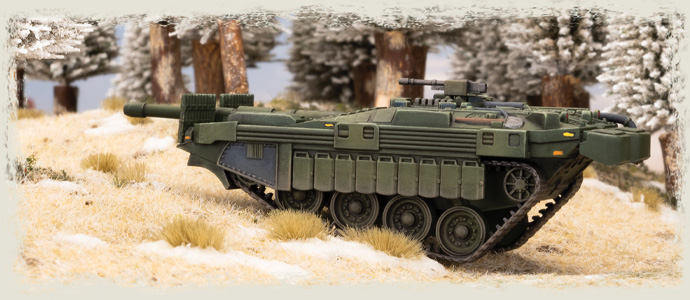 |
It is also fitted with an autoloader to reduce its crew size and replicated controls so that the commander or gunner may drive the tank and fire the main gun. A third crewman is a radio operator/driver and sits in a rearward-facing position from where they have another set of driving controls for rapid re-deployment. While the Strv 103 S-Tank cannot fire while moving, the autoloader combined with short halt firing tactics allows it to fight well on the advance. The S-tanks excellent long 105mm gun has AT21 and can hit targets out to 48”/120cm. It utilised its low silhouette and hydropneumatic suspension on defence among the wooded terrain of Sweden. This is represented by the Ambush tank rule: If an S-Tank is stationary, it can remain Gone to Ground while shooting its main gun. It also has Slat (or bar) armour that is fitted to the front to improve its front and side armour to 13 versus HEAT weapons. |
|
The Swedes also fielded the British Centurion. This has undergone many upgrades through the years. The latest variant is the Strv 104 Centurion. Strv 104 Centurion Tank Companies are organised like the S-Tank formations. The Strv 104 Centurion is fitted with a new American diesel engine, 120mm thick sloped armour with additional explosive reactive armour (ERA), the British 105mm L7 rifled gun, and new fire control systems (including a Laser Rangefinder). The other half a Swedish mechanised battalion is the Pansarskyttekompanier (armoured shooter/rifle companies). Each battalion had two companies with three Pansarskyttepluton (armoured shooter/rifle platoon) and a Pansarvärnspluton (anti-tank platoon). Additional weapons units from the battalion and brigade provided further anti-tank and armoured support. The Formation can include attached Tank Platoons, Ikv91 Tracked Anti-tank Platoons, tracked or ground anti-tank missiles, mobile recoilless rifles, and recon. |
|
A Pbv 302 Armoured Rifle Platoon is mounted in the Pbv 302 APC mounted a 20mm autocannon. The Swedish Pansarskyttepluton (armoured rifle platoon) consists of three skyttegrupper (shooting groups) (3x Ksp-58 MG teams), as well as a granatgevärsgrupp (grenade launcher group) of 3x Grg m/48 (84mm Carl Gustav recoilless rifle) anti-tank teams. Each Skyttegrupp is usually assigned four P-skott m/68 (74mm Miniman) disposable anti-tank weapons. The Ikv 91 (Infanterikanonvagn 91, infantry cannon wagon 91) is a high-mobility assault gun developed for the Swedish army. Its design employs common components with the Pbv 302 APC series. It is armed with a 9cm cannon and fitted with a Laser Rangefinder. It has a range of 36”/90cm and AT17. |
|
The Pvrbv 551 Anti-tank Missile Platoon is armed with the Pansarvärnsrobotbandvagn 551 (Pvrbv 551). It is a tank hunter mounting an Improved TOW anti-tank guided missile system. The American iTOW (Swedish designation: RBS-55) gives it good range (48”/120cm, Guided) and anti-tank capabilities (AT21, HEAT). Another unique Swedish vehicle is the Pvpjtgb, which is the Swedish military abbreviation of Pansarvärnspjästerrängbil (armoured defence patrol car), the Volvo C303 off-road vehicle. In the Pvpjtgb RBS Anti-tank Missile Platoon, it mounts either the RBS-55 iTOW or RBS-56 BILL anti-tank guided missile systems. In the Pvpjtgb 90mm Anti-tank Platoon, it mounts the Pvpj 1110 Bofors 90mm recoilless anti-tank gun. |
|
Swedish Support comes from self-propelled artillery, self-propelled anti-aircraft missile vehicles, HKP 9 anti-tank helicopters, Viggen strike aircraft, plus further anti-tank missile and anti-tank units and recon. Swedes have access to NATO Allies as Formations, as well as Finnish Units as part of their Force Diagram. |
| Swedish Models The Swedish range introduced the excellent S-tank as a plastic kit available in a box of three tanks (TSWBX1). The Strv 104 Swedish Centurion tank is the first of our Centurion plastic kits to come out and comes in a box of five tanks (TSWBX02). The Ikv 91 tanks are available as resin kits in a box of three tanks (TSWBX04). The massive Bandkanon 1 Self-propelled gun, Sweden’s autoloading 155mm artillery also comes in a box of three resin kits (TSWBX06) |
 |
The Pvpjtgb 1111 Platoon (TSW120) provides you with four vehicles with all the resin parts to make Pvpjtgb 90mm Recoilless Rifle Jeeps, Pvpjtgb RBS-55 iTOW Anti-tank Missile Jeeps, or Pvpjtgb RBS-56 BILL Anti-tank Missile Jeeps. |

